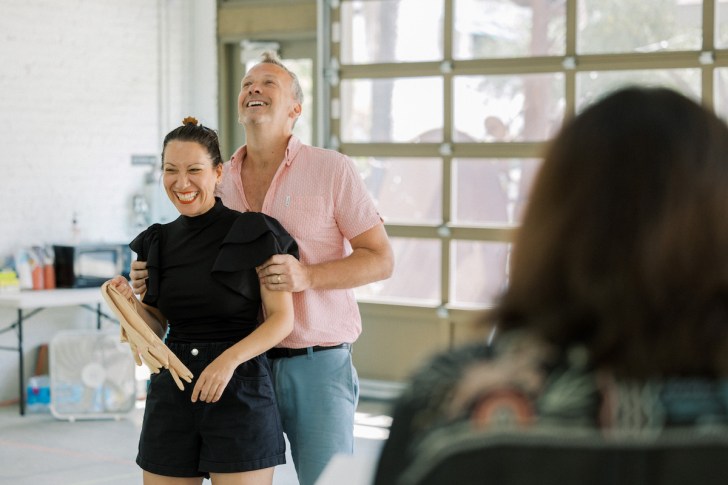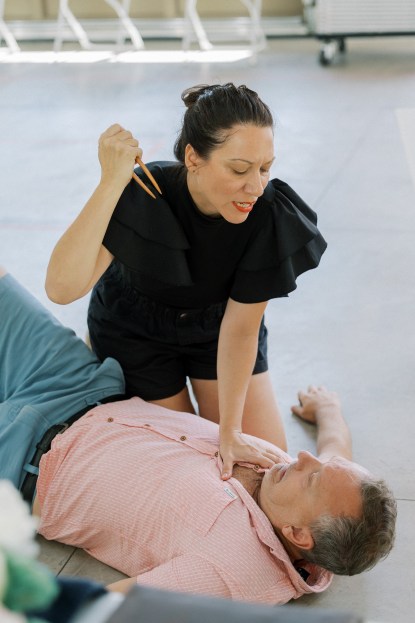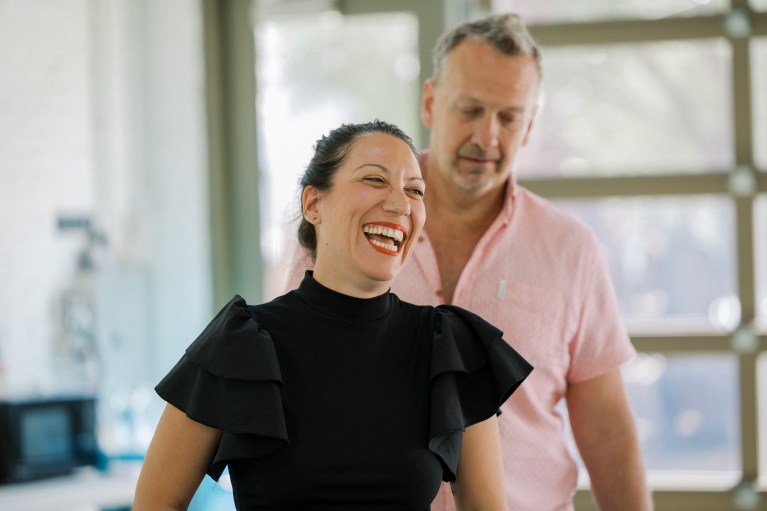Opera Santa Barbara
Goes Grand at the Granada
Following Adaptive Pandemic Seasons,
Company’s Season Launches with Tosca
By Josef Woodard | September 29, 2022

Read all of the stories in our “Fall’s Cultural Harvest” cover here.
It can be said that over the last two-plus years of perilous times for culture in Santa Barbara, opera has been down but never out. Under the intrepid and resourceful guidance of Opera Santa Barbara’s head, Kostis Protopapas, opera has gone to the drive-in and into various humbler and alternative side routes, and finally returned in grand form to the Granada with La Traviata in June.
On Saturday, October 1, at The Granada Theatre (note 6 p.m. start time), the company returns to its operatic grandeur mode, launching its new season with the beloved Puccini opera Tosca. This new production, directed by Layna Chianakas and featuring mezzo-soprano Eleni Calenos and tenor Adam Diegel in lead roles, kicks off a full October-to-May season of Italian, American, and Wagnerian opera fare, in a time still lined with cultural vulnerability but also high hopes.
Among the creative and proactive measures being put into place this season are the “You Decide!” flexible ticket pricing, single performances to reduce overhead, and free tickets for high school students.

In a recent interview, Protopapas addressed the aforementioned high hopes, new plans, and the vexing complexities of running an opera company during and beyond the pandemic.
You have braved the pandemic struggles beautifully, with a great resourcefulness and creative lateral thinking. Do you view the 2022-23 season as a true “return to regular programming,” after two seasons of reinvention?
The 2022-23 is a logical continuation of what came before. The period between March 2020 and June 2021 restricted some of the things we could do but opened the door to other things. We were forced to experiment, and we are stronger for it.
The post-2021 programming has been a combination of things that “came back” from before but for which we now have a fresh perspective, and new things that we decided to keep but expand based on the post-reopening opportunities. One way in which we evolved is that we now feel comfortable putting on shorter operas. What never changed was our passion for great music theater and for building a strong bond with our community.
Do you feel a sense of relief, in the organizational aspect of running an opera company?
Uncertainty, complexity, and ambiguity are constant in the performing arts. I have built a high level of tolerance for those over time, and that helped me get through the last couple of years. It’s certainly good to not be operating in a climate of constant fear, but otherwise, running an opera company is always exhilarating, rewarding, and terrifying in equal measure.
You ended last season with a classic Italian opera, La Traviata, and will launch this season with Tosca — almost fitting in its opera-within-opera structure. How do you view Tosca in terms of its place in standard operatic repertoire?
Tosca is my favorite Puccini opera: It is taut, cinematic, and has glorious music. It also lovingly pokes fun at the opera itself, which I believe is one of the reasons it’s so popular. Deeper down, it explores the relationship between the artist and the world around them. Mario, a painter and Tosca’s lover, is an artist with a strong political conscience. Tosca finds out the hard way that art does not shield you from reality. Art and history are inseparable, and we forget that at our peril. Living for art and love alone is not possible.
Are there particular new elements or period settings involved in this particular production?
I’m really excited about what we’re doing with this production. We’re combining period costumes and props with digital projections and film sequences. Tosca feels like a movie under any circumstances, so introducing the film element feels natural. Tosca is also the only opera that is set entirely in well-known historical locations, and the digital projections will transport us there. We’re going for a production that feels modern without disturbing the period setting or imposing any concept of modernism.



From left: Layna Chianakas, stage director; Adam Diegel, tenor; Eleni Calenos, mezzo-soprano | Credit: Courtesy
Your four-opera season seems nicely balanced — Tosca with the lesser-known Italian opera, Rossini’s La scala di seta, Jack Perla’s An American Dream from the contemporary corner, and a next Wagnerian Ring installment. In a way, it’s a more conventional season compared to the adventurous turns of last season, but also attentive to the importance of being diverse. Was that your thinking in the programming process?
We always go for a mix of classic and traditional. Since every opera is different, the balance shifts a bit one way or the other from season to season. We put together seasons that balance out in terms of periods, languages, financial realities, and, most importantly, represent who we and our community are at any given time.
As the only full-time professional opera company between Los Angeles and San Francisco, a big part of our mission is to present strong productions of the classics, both for the people who love them, and for those who would otherwise never see them.
Tosca is our annual big classic offering. La scala di seta brings some lightness to the season, and is a vehicle for Jana McIntyre, who dazzled as Semele last year. An American Dream is a piece I’ve wanted to do for a long time and fulfills our company’s pledge to produce one American opera each season. The Valkyrie has been in the pipeline since 2021 when people asked for more Wagner after the success of Das Rheingold.
I assume you are still putting pieces back together again in terms of financial and logistic resources, in the post-pandemic era — a common and lingering reality for many arts organizations. Is that partly the reason for such developments as the single-performances and “pay what you wish” policy?

The move to a single performance is something we were already discussing before 2020. Demand for classical music events has been going down for a long time nationwide. Attendance of our own productions of the “top 10” operas at the Granada has dropped 31 percent over the last 10 years.
Organizations around the country are struggling with similar trends and are trying different solutions. Most seek to address the problem through some combination of increased reliance on donations with filling the house by handing out free tickets. We have a different view. We see paid attendance as a hard metric that shows you to what extent your community needs and values what you do. Sustainable success depends on balancing artistic ambition with audience demand.
Empty seats are bad for morale, drive marketing costs up, and misrepresent the value of the work on stage. Our goal is to have sold-out performances and recoup 40 percent of production costs through ticket revenue every season. At the same time, we want our tickets to be accessible to anyone who wants to attend. Here is where the name-your-own-price tickets come in.
Our You Decide! ticket program invites everyone who wants to experience live professional music theater to put a price on how much that experience is worth to them, based on their level of interest and financial circumstances. We want a full house where every patron shares in the responsibility of supporting the art on stage according to their means.
Do you find that opera audiences (and those who don’t yet know they’re opera fans) are especially eager to get back into the theater to experience this very live art form again, as an escape from screens and digital interfacing, for one?
To some extent. Inertia is a hard force to counteract. After a couple of years of staying at home, people have developed new habits. Additionally, post-reopening travel is higher on many people’s agenda than theater. Attendance was way down in 2021-22, and I expect the recovery to be slow.
Anything else you would like to add about Tosca, or the coming season?
About Tosca, I want to share that this is the first time I’m conducting it, and I am beyond excited for that. About the season, I want to give people a heads-up that there is a fifth offering that will be revealed after Tosca. I can’t wait to announce it, so everyone should stay tuned.





You must be logged in to post a comment.